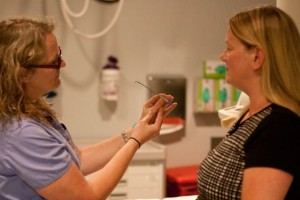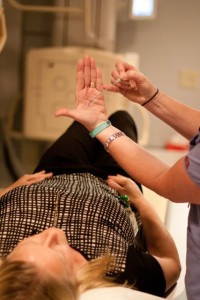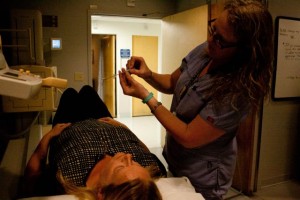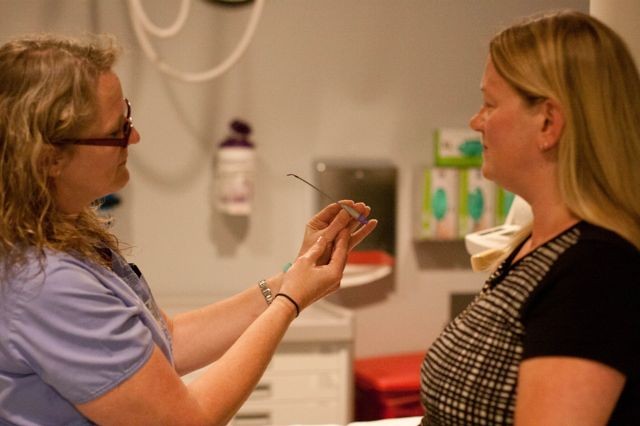
For 35 years, Kristin Melton suffered from chronic migraines. She tried everything to manage her pain, but after seeing three neurologists and trying countless medications, she was sure her condition was one that would debilitate her for the rest of her life. That is until she tried a new procedure being offered at Grays Harbor Community Hospital called SphenoCath. She’s been migraine-free since.
SphenoCath, which was introduced in 2013, is a new procedure that uses a flexible plastic catheter to deliver a Sphenopalatine ganglion (SPG) block through the nose to stop migraine pain in its tracks. By applying anesthetic to the catheter and using radiologic imaging equipment to guide the catheter through the nose to a depression located behind the nasal cavity, SphenoCath is revolutionizing the way doctors treat chronic migraines.
Kimberly DuBore, RN BSN a Diagnostic Imaging nurse at Grays Harbor Community Hospital first learned about SphenoCath after meeting a doctor who was lecturing on the subject at a medical conference she attended earlier this year. Inspired by the innovative procedure, DuBore brought the information back with her to Grays Harbor and presented it to Dr. Joe Stengel, DO, at Grays Harbor Community Hospital. “Dr. Stengel was willing to step up to the plate and help spearhead this with my help,” explains DuBore.

Dr. Stengel, who has been working at Grays Harbor Community Hospital since 2008, says SphenoCath is the modern-day advancement of a procedure that has existed for more than 100 years. Originally the procedure was performed using a cotton swab dipped in lidocaine that was then inserted four inches up the nose. It was extremely uncomfortable and rarely effective. Today, using modern technology, SphenoCath is less invasive and has an effective rating of 75 to 80 percent.
In addition to having a high effectiveness rating, many of the patients who have the SphenoCath treatment done only need to have it once. Dr. Stengel says this is because SphenoCath works kind of like a reset button.
Chronic migraine pain and similar conditions are the result of pain fibres travelling through the face and head. But before they reach the parts of the face and head where pain is experienced, they first have to go through that hard-to-reach depression behind the nasal cavity — an area Dr. Stengel describes as a circuit breaker. Many patients who have had the procedure have only needed to have it done once. Dr. Stengel says SphenoCath is effective because when the SPG block is applied to this “circuit breaker,” it essentially turns the circuit breaker off, stopping pain immediately.
“We know that lidocaine will stop a headache, but the amazing thing is by turning off that breaker, we’re somehow allowing that whole system to reset,” says Dr. Stengel.
However, the procedure’s effectiveness varies from case to case, as seen in patients who suffer from conditions similar to chronic migraines, like cluster headaches and trigeminal neuralgia.

Kelly Phelps, a hospital employee who learned of the procedure earlier this spring, volunteered herself for the procedure hoping it would put her painful trigeminal neuralgia symptoms at bay. Phelps, who was diagnosed with trigeminal neuralgia last fall, says she suffers from crippling pain on the right side of her face daily. Phelps says prior to the SphenoCath procedure, her pain was so severe that by the time she would get home from work at 3:00 p.m., she would go straight to bed.
Phelps has had three SphenoCath procedures since April and says the result has been transformative. Now able to do simple things like run errands and enjoy dinner with her husband, Phelps says SphenoCath gave her her life back. And because SphenoCath has no harmful side effects, Phelps can rest assured knowing that if she needs another treatment, she can schedule one quickly and be feeling better in as few as 25 minutes, the time it takes to do the procedure.
Melton, who has only had the procedure done once, says she knows the “reset button” may not last forever, but knowing that there’s a treatment out there — right here in Grays Harbor — that can help her overcome her chronic pain is a comforting feeling.
Interested in trying SphenoCath for yourself? Grays Harbor Community Hospital is in the process of accepting patients for its new SphenoCath procedure, and DuBore says most insurance companies cover the treatment but may require your doctor’s authorization in advance. DuBore invites people interested in learning more about SphenoCath to contact her or Dr. Stengel at Grays Harbor Imaging at 360-537-5161.












































